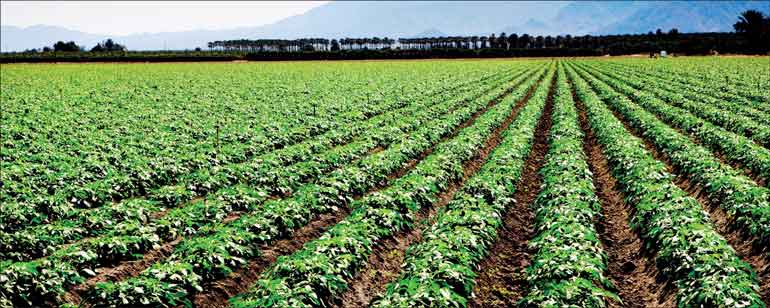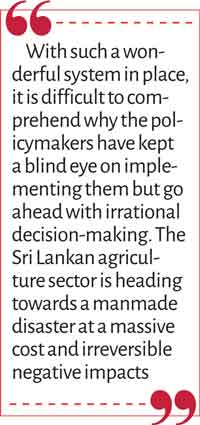Monday Dec 29, 2025
Monday Dec 29, 2025
Wednesday, 23 March 2022 00:30 - - {{hitsCtrl.values.hits}}

It is a shame, and I feel incredibly sorry for the 22 million consumers of Sri Lanka, including our farming community and myself, for not being able to convince or force the ignorant policymakers in this country to make rational decisions on agriculture at the correct time. We are heading towards the most disastrous scenario that the country’s agriculture has ever experienced (leaving the other economic sectors out for a moment), at least since gaining independence in 1948.
to make rational decisions on agriculture at the correct time. We are heading towards the most disastrous scenario that the country’s agriculture has ever experienced (leaving the other economic sectors out for a moment), at least since gaining independence in 1948.
Some academia, scientists, social activists, and farmers/practitioners in Sri Lanka voiced serious concern since they heard of the ill-fated decision taken by the Government on 27 April 2021 to ban the importation of two key categories of agricultural inputs i.e. synthetic fertiliser and pesticides. This decision had some legal teeth for its implementation with the issue of an extraordinary gazette notification (No. 2226/48) on 6 May 2021. The import ban was made effective when the previous Yala season (in 2021) had just started, and some synthetic pesticides and fertiliser were already imported. Any remains of agrochemicals from Maha season (2020/2021), and some imported even later due to the efforts of the Ministry of Plantation and others, would have supported farming in the previous Yala season (2021).
By early last year (2021), the Department of Agriculture had all plans to strengthen the Good Agricultural Practices (GAP) certification program and popularise Precision Agricultural technologies in the national crop productivity enhancement efforts. Until a year ago, the country’s agriculture sector was moving along the correct direction with a vision, with experience gained from over seven decades of scientific research and development since gaining independence in 1948 and using lessons learned from the traditional agricultural practices.
But this progression was hit hard later by totally unscientific decision-making. Lack of foreign currency was never brought forward as a concern for taking such an unwise decision. Even the agriculture policy prepared during the era of this Government, where the writer was one of the 13-member team initially appointed by the Secretary to the Minister of Agriculture, had GAP highlighted as a technological package to maximise the agriculture sector’s contribution to national food security.
Since 2008, paddy production of Sri Lanka has shown a stable and increasing trend where the country could produce more rice than what we can consume. With these efforts, Sri Lanka was positioned stronger during the two world food price crises in 2008 and 2011. Sri Lanka was also at the top among the South Asian countries on the Global Food Security Index (GFSI) from 2010 to 2019. The rice imports were at quantities less than 1% of the total required, and such imports mainly focused on the tourism industry and others with purchasing power that needed speciality rice such as Basmati, etc.
In 2016 and 2017, however, climate change affected our agriculture sector badly, and the country faced a drought that is probably the worst since 1948. Three cultivating seasons failed continuously and compelled the then government to import around 700,000 mt of rice to feed our nation. At that time, the total requirement of rice per year was around 2.4 million mt. The imports in 2017 reached approximately 29% of the requirement (i.e. to feed our nation for about 3.5 months). Sri Lanka bounced back in 2018, producing rice once again in quantities more than what we required. The trend continued until the end of the Yala season last year (2021).
As for paddy farming, 2021 was exceptional, and we did well to have a good crop harvest. The paddy harvest in 2021 is the sum of the yield in Maha season 2020/2021 (3,061,394 mt) and Yala season 2021 (2,088,486 mt) = 5,149,880 mt. Many factors have contributed to the increase in paddy production in 2021. Despite lockdowns in 2020, the Sri Lanka Government allowed the farming community to work freely in their fields, which is a good move. This decision, coupled with the timely availability of agricultural inputs such as synthetic fertiliser and pesticides, contributions of the scientists, academia, and more importantly, the farming community who understood the ground realities, and the policy decision made before 27 April 2021, have contributed to reap rich harvests from many food crops in 2021.
It is now more than evident that the national level paddy yield in Sri Lanka in the Maha season 2021/2022 will show a 40-45% drop compared to the average of past Maha season yields. The main reason for this yield drop is the total shift from synthetic fertilisers to organic fertilisers envisaged by the politicians through policy directives. Knowing how organic fertiliser (solid or liquid) works on crops, the fate of organic matter in a tropical environment, and that organic fertiliser alone will not be in a position to provide the required quantity of nutrients at the correct stage of growth of a crop, this is an obvious outcome. The academia and scientists had no difficulty making such fairly accurate predictions of yield losses beforehand but were not considered by the policymakers and their close associates.
2021/2022 will show a 40-45% drop compared to the average of past Maha season yields. The main reason for this yield drop is the total shift from synthetic fertilisers to organic fertilisers envisaged by the politicians through policy directives. Knowing how organic fertiliser (solid or liquid) works on crops, the fate of organic matter in a tropical environment, and that organic fertiliser alone will not be in a position to provide the required quantity of nutrients at the correct stage of growth of a crop, this is an obvious outcome. The academia and scientists had no difficulty making such fairly accurate predictions of yield losses beforehand but were not considered by the policymakers and their close associates.
The maize production was doing quite well, producing more than 415,000 mt of maize from the 2020/2021 Maha season and more than 50,000 mt from the 2021 Yala season. However, the absence of synthetic fertilisers and pesticides during the Maha season 2021/2022 has resulted in maize production ending in a disaster. The scientists and practitioners now predict that we will be producing a mere 60,000 kg of maize during the season, which is a massive drop compared to what the country achieved in the previous Maha season in 2020/2021.
To minimise the impact on the animal feed industry, the Government recently decided to allow the importation of maize. The ever-increasing prices of chicken meat in the domestic market indicate an increasing cost of production mainly owing to lack of animal feed and high cost of inputs for formulating animal feed. What a price the society has to pay in return for irrational policy decisions made!
On the surface, the tea sector has performed well. The total made tea production in 2021 was 299 million kg, thanks to the excellent weather prevailed and efforts made by the Ministry of Plantation to import some quantities of synthetic fertiliser. However, this 21 million kg increase experienced compared to 2020 was mainly coming from the tea production during the first five months, before any impact of the unfortunate decision imposed. We should have easily hit the targets of producing 320 million kg of made tea, if not for the drawbacks experienced towards the latter parts of the year. It is not only that we fell short of expectations; the last three months of 2021 produced less than 12+ million kg of made tea compared to 2020. Had we sold tea even at a lower price of $ 2 (not to undermine the quality of Ceylon Tea), the additional foreign exchange earnings should have been around $ 25 million from the last three months of 2021 alone. The story did not end there. We now know that the tea production in February 2022 has fallen by 20% more than that of February 2020 to 18.16 million kg, the lowest monthly production ever recorded since 2009 (12.8 million kg).
The decision to ban the import of synthetic fertiliser and pesticides was finally revoked on 30 November 2021 by the Extraordinary Gazette No 2256/23. However, we had missed the opportunity for timely importation of the agricultural inputs before the dramatic price increase observed in the world market. Our policymakers have let down the agricultural economy, the farming community, the academia, the scientists of the Department of Agriculture and other commodity research institutes, and the progress made over decades by the food and feed crop production sector of the country. The cost is enormous; losses are irrecoverable.
Some seem to think that paying compensation to the farmers is a measure to get away from the errors and sins committed. Paying Rs. 40 billion for paddy farmers alone only for Maha season, against the total commitment of Rs. 36 billion made in 2020 to import synthetic fertiliser for all crops in Sri Lanka for the whole year, is not something that anyone can be proud of. It is a good reflection of not considering the economics of the entire system.
Despite the obvious negative impacts, the Government has shown all signs of following the same principle during the Yala season 2022. This decision to continue with organic or green agriculture does not make sense in the present context. Had we allowed agriculture to continue in the usual manner in the Maha season 2021/2022, without disrupting it the way the Government has done, the country should have been in a better place in terms of food security this year (2022). We would have faced the next Yala season with confidence under the changing global political scenario. At least, we should have avoided the food import expenditure and the import cost of ‘organic’ fertilisers (that could even do more harm to the Sri Lankan environment).
We also learned that some in society did not favour seeing scientists and academia providing realistic negative results against the Government’s decision to take the country on an ‘organic/green agriculture’ pathway. They may either want to show loyalty to the government and support and implement whatever the directives come from the political hierarchy or pretend to know the actual negative impact but let the government fail in its efforts and popularity. The illogical efforts have failed, and the predicted adverse effects by scientists and academia are now a reality even at higher scales.
Continuation of such an ill-fated approach for agriculture in the Yala season 2022, there is no doubt that paddy, other food and feed crops, and tea production in Sri Lanka would hit rock bottom. Further price hikes, food shortages, and lower agricultural export earnings, mainly from tea, are imminent. All signs are clear that the target of maximising the contribution of Sri Lankan agriculture in achieving national food security will be a dream.
Furthermore, the Government has contradicted itself by the different ad hoc decisions. It all started to avoid wasa-wisa and make the nation healthy. But there seems to be no effort to assure the quality of imported rice and other human food in Sri Lanka. What a pathetic situation! Our policymakers have made Sri Lankans rely on another country for the staple food! How can any Sri Lankan even dream of doing such damage to the country’s agriculture?
 Suddenly, Sri Lanka has become a predominantly rice-importing country for the foreseeable future, after about 14 years due to a manmade problem. Early this year (2022), the government decided to import 300,000 mt of rice from Myanmar (repeating the situation in the 1940s where we imported 60% of our rice requirement mainly from Myanmar to feed a mere 6 million population) and requested one million mt of rice from China, with no positive response. These two requests alone account for more than 54% of the annual rice requirement of the country. Furthermore, the Government has opened up for anyone to import rice. We had seen that Indian rice products were freely available in the market even before the Indian credit line was approved. The policymakers seem to be still happy and proud that they can flood the markets with imported food items during the Sinhala and Hindu New Year period. What a line of thinking after ruining the agriculture sector! The $ 1 billion Indian credit line includes food imports. Let us not call that begging! Our pride has been beaten to death.
Suddenly, Sri Lanka has become a predominantly rice-importing country for the foreseeable future, after about 14 years due to a manmade problem. Early this year (2022), the government decided to import 300,000 mt of rice from Myanmar (repeating the situation in the 1940s where we imported 60% of our rice requirement mainly from Myanmar to feed a mere 6 million population) and requested one million mt of rice from China, with no positive response. These two requests alone account for more than 54% of the annual rice requirement of the country. Furthermore, the Government has opened up for anyone to import rice. We had seen that Indian rice products were freely available in the market even before the Indian credit line was approved. The policymakers seem to be still happy and proud that they can flood the markets with imported food items during the Sinhala and Hindu New Year period. What a line of thinking after ruining the agriculture sector! The $ 1 billion Indian credit line includes food imports. Let us not call that begging! Our pride has been beaten to death.
But, is there a way out? Yes. The solution is clear. The issue is that the policymakers have been adamant to go ahead to realise their whims and fantasies but not facing reality. For example, suppose the objective is to minimise misuse (overuse, under-use, indiscriminate use…) of fertiliser and pesticides, ensure food and environmental safety, reduce the cost of production and enhance productivity. In that case, the near-perfect solution is to adopt SLGAP-certification with full Government patronage.
The SLGAP-certification is free of charge and done by the Department of Agriculture (DOA) and the Department of Export Agriculture (DEA), unlike the costly third-party certification generally carried out for organic agriculture/farming. We require more trained staff to get this process on the ground in a more progressive manner and ensure the market mechanisms are in place to support the SLGAP-certified agricultural products.
The SLGAP focuses on adopting the recommendations by farmers judiciously to ensure higher crop productivity and safety, including integrated plant nutrient management systems (IPNS) and integrated pest management systems (IPM, including weed management), and embedded with climate-smart agricultural practices. The DOA formally introduced the process in 2016. The Sri Lanka Standards Institutions (SLSI) through SLS 1523 has provided required standards for different commodities to support SLGAP farmers and the certification process.
Sri Lanka also prepared the National Guidelines for Climate Smart Agricultural Technologies and Practices in 2019, complementing the SLGAP-certification program. With such a wonderful system in place, it is difficult to comprehend why the policymakers have kept a blind eye on implementing them but go ahead with irrational decision-making. The Sri Lankan agriculture sector is heading towards a manmade disaster at a massive cost and irreversible negative impacts.
(The writer is a lecturer at the Department of Crop Science, Faculty of Agriculture, University of Peradeniya.)